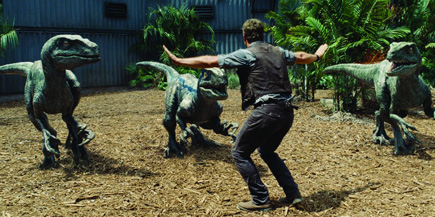|
|
Top Film Industry Stories of 2015:
|

|
Jurassic Park III paid the price for the abysmal quality of the second film. Despite standing out as a smart, innovative story about parents trying to save their child trapped on Isla Sorna, the third title in the franchise failed to excite North American audiences. In fact, its opening weekend bested the original Jurassic Park by only $600,000 despite eight years of ticket price inflation. It eventually earned less than half of the first film, finishing with $181.2 million. This is a good time to mention that it cost $30 million more to produce. New at BOP: Share & Save
![]() Tweet
Tweet
![]() Print this column
Print this column
Fourteen long years passed between the box office disappointment of Jurassic Park III and the debut of Jurassic World. During this time, Steven Spielberg and his team deduced the miscalculation above. They finally had the epiphany that they’d unintentionally left audiences hanging for over 20 years. People wanted to watch a movie about a dinosaur amusement park. Instead, the Jurassic Park sequels provided complete nonsense like when a teen gymnast cut from her high school team somehow warded off a dinosaur attack thanks to her parallel bars training. In order to craft the best possible Jurassic Park sequel, the franchise needed to go back to the basics.
The advertising campaign for Jurassic World was all about the basics. It highlighted all the ways in which the producers were admitting past mistakes in the franchise. They were leaving behind Isla Sorna from the first three films. The ethically challenged InGen Corporation had to find a new development since their last island got swarmed by dinosaurs. They moved along to Isla Nubar, a Central American locale where new ownership, the Masrani Global Corporation, could reinvent the dinosaur wheel, this time with more control of the process.
All of the above simply frames the backstory of how Jurassic World rose from the ashes of the failed Jurassic Park experiment. Everything else about the marketing campaign emphasized precisely what people wanted from a new dinosaur movie. It was effectively the same story as the original, only with the highest quality special effects available 22 years after the original film. Also – and this is critical to the popularity of Jurassic World – the park was now open.
Why do consumers need an open theme park? Well, for starters, it allows the producers of Jurassic World to add a touch of reality to the proceedings. Several humorous touches such as Magic Bands and learning centers unmistakably remind people of Walt Disney World and other Disney theme parks with just a fair share of Universal Studios thrown in since this is a Universal production. The conceit is that kids get to live out their dreams by interacting with the dinosaurs just as they can play with other beasts at Disney’s Animal Kingdom.
That’s only half the story, though. The other explanation is darker. More people in the parks means more potential victims. And if we’re being honest with ourselves, that’s what we all want from the Jurassic franchise. The marketing for Jurassic World doubles and then triples down on this premise. First, the commercials introduced the Indominus Rex, a genetically enhanced super-dino that can bully other dinos. Then, they throw in the majesty of the Mosasaurus, a very real aquatic dinosaur 60 feet tall in stature. Simply stated, Universal sold the new Jurassic feature as bigger, badder, and better in every way.
Universal also caught a break when a mildly popular television sitcom actor, Chris Pratt, suddenly became the It Actor in Hollywood after principal photography ended. His 2014 release, Guardians of the Galaxy, evolved into one of the surprise blockbusters of the year, thereby cementing him as a movie star. The timing of Jurassic World’s release was kismet, as he had only grown in popularity as the months advanced. By the end of the dinosaur film’s opening weekend, he was arguably one of the strongest box office draws in the industry as well as the subject of a viral meme involving the taming of velociraptors and, well, any other type of animal.
The results of all these positives speak for themselves. On its first day, Jurassic World grossed $82 million, already giving it the title of biggest Jurassic franchise opening ever. The sequel went on to break the opening weekend record with $208.8 million, although it held the title for only seven months until Star Wars: The Force Awakens debuted.
Jurassic World wasn’t simply a one-weekend wonder, either. To the contrary, it showed some of the strongest legs ever for a movie of this scale. It grossed $443 million domestically AFTER opening weekend. That tally alone would place the film in the all-time top ten for North American box office. In combination with the historic opening weekend, Jurassic World became the most popular non-James Cameron film to that point, eventually earning $652.2 million. It fell only $6.5 million short of Titanic, and that’s solely due to Titanic enjoying a re-release in 2012.
The latest Jurassic title also became only the fourth film to earn over a billion dollars internationally, which shockingly happened twice in 2015 for Universal, cementing their amazing box office year. Jurassic World’s global take of $1.67 million was also the best non-James Cameron total ever right up until Star Wars: The Force Awakens debuted. Honestly, Jurassic World would be the largest Film Industry Story of many years. It simply had the “misfortune” of doing so amazingly well in 2015, the year of epic box office performances.
Continued:
1
2
[ View columns by David Mumpower ] [ Email this column ]

|
|
|

|
Tuesday, July 1, 2025
© 2025 Box Office Prophets, a division of One Of Us, Inc.

